| Sunbeamland
Early History
Jeddo Works was situated at the end of
a small track off the Penn Road. The buildings were acquired by
Edward Perry, some time before 1842. Perry began his career as a japanner
with his father Richard who learned the trade at the Old Hall works, then started his own small business
in Brickkiln Street, before moving to Temple Street. Edward Perry
started his business at 7 Queen Street, Wolverhampton before moving to the larger Jeddo Works, in order to
increase production.
St. Paul’s Church was built in 1835, presumably
Paul Street was built at the same time.
Pigot & Company’s 1842 directory lists the
factory as follows, under Japanners: Perry, Edward (& fancy
Pontipool work etc.), Paul Street.
The factory is shown on the 1842 Tithe map, and
identically on Joseph Bridgen’s map of 1850. The maps do not mark
individual building boundaries, only built-up areas. A ‘U’ shaped
area is marked on the site of the works. Part of the area in Paul
Street was occupied by a row of 6 terraced houses behind St. Paul’s
Church, which are clearly marked on the 1885 and 1901 Ordnance
Survey maps. Apart from the houses, the remainder of the shaded area
would have been the factory. |
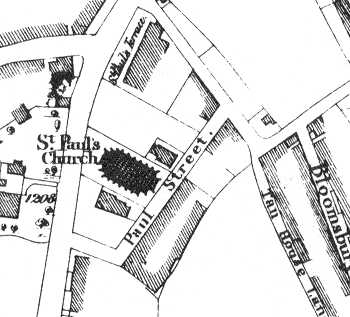 |
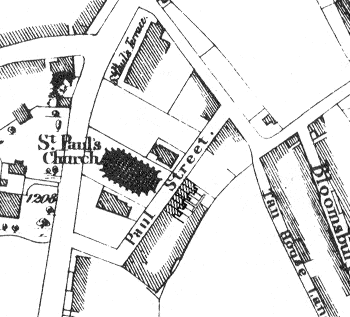 |
|
Jeddo Works, as
seen on the 1842 Tithe map. The image on the right has
the row of houses superimposed. |
|
|
Perry is listed in White’s Staffordshire
Directory of 1851 under Japanware manufacturers & iron and tin plate
workers, as follows: Perry, Edward, Jeddo Works, Paul Street.
Jeddo works was presumably named after Jeddo in
Japan, the site of the Imperial Palace in the mid 19th century.
Jeddo Street is not marked on either the 1842 Tithe map, or
Bridgen’s 1850 map. It is listed in White’s 1851 directory, so
presumably it was built in 1850 or 1851 and named after the works.
Pool Street, originally Tall House Lane was probably renamed at the
same time as the building of Jeddo Street.
| |
|
|
 |
|
Read about the Great Strike
at Jeddo Works in 1850-51 |
| |
|
|
The only other building on the eastern side of
Paul Street, on the corner of Pool Street, was Joseph Cooper’s lock
works, which was still there until 1911 when Sunbeamland was
extended into Pool Street. |
|
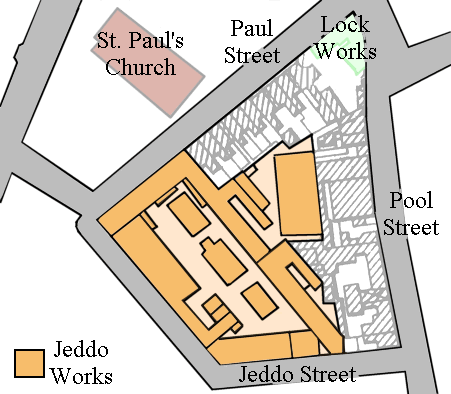
Jeddo Works after 1877 (based on the 1885
Ordnance Survey map). |
John Marston signed indentures with Edward Perry in 1851 and
served his apprenticeship at the works. Afterwards he purchased
Daniel Smith Lester’s Japanning business at Bilston. Edward
Perry died 1869, and in 1871, Marston purchased the works and became one of
the largest manufacturers of japanware in the country.
The factory was rebuilt around 1877 and new buildings were added.
John Marston Limited produced a wide range of domestic holloware,
including bread dishes, dish covers, pots, pans, kettles, spirit
lamps, foot warmers, and black enamel ware. |
| From the map opposite it can be seen that the 1877 rebuild was
extensive. It seems likely that all of the original buildings were
replaced in the process. By 1881 the company employed 84 men, 41
women, and 19 boys.
The Sunbeam name was registered in 1888
at the time when bicycle production was just beginning at the works.
Around this time the name of the works was changed to Sunbeamland,
a name that remained until the late 1930s, after the Sunbeam name
and products were sold to AMC. |
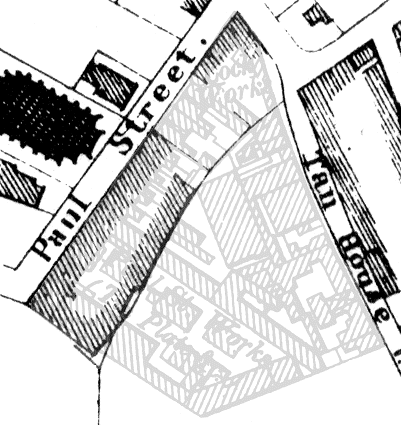
The original factory superimposed on the 1877
buildings. |

The early Sunbeamland, from the junction of Paul Street
and Jeddo Street.. It clearly shows the 1877 buildings.
|
In 1911 the factory was greatly extended. The
remaining houses in Paul Street, Cooper's Lock Works, and all of the
adjacent buildings in Pool Street were demolished to make way for
the new development. When the work had been completed, the factory
(externally) looked much as it does today, filling the whole of the
east side of Paul Street, and the northern end of Pool Street.
Another building which has now disappeared can be seen in the top
right-hand corner of the photograph below. It stood on the opposite
side of Jeddo Street and was linked to the main factory by a covered
bridge. |
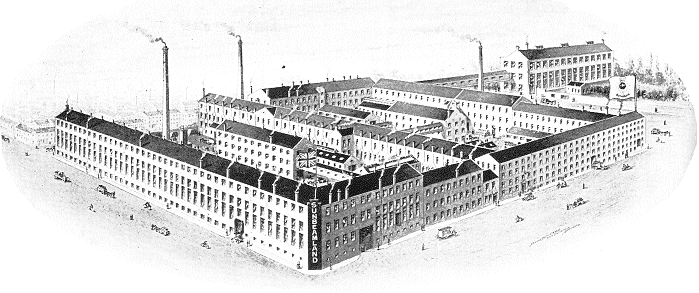
The factory after 1911 with Pool Street on the left,
and Paul Street on the right.
| The next important changes took place in 1934, towards the
end of the ailing motorcycle and bicycle production. The company
had clearly decided to concentrate on building radiators at this
time. Radiator production was very profitable and became the
mainstay of the business. It was decided to mechanise radiator
production in order to increase productivity and profitability.
As a result many of the internal buildings, and one of the
external buildings in Jeddo Street were demolished, and replaced
with the buildings that still occupy the central yard. A small
two storey building in Paul Street was also demolished, and
replaced with an extension to the building at the western end of
Paul Street. It seems likely that at this time the building on
the opposite side of Jeddo Street, and the linking bridge were
also demolished. The factory in
the early 1920s |
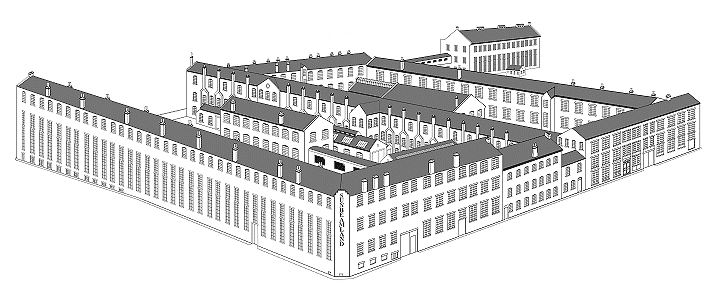
An impression of Sunbeamland in the early 1920s.
| The drawing above gives an impression of how the factory
looked in the 1920s, as viewed from the junction of Pool
Street (on the left) and Paul Street (on the right). The
buildings in Pool Street were part of the 1911 development,
as were both end buildings in Paul Street. The two centre
buildings in Paul Street possibly date from around 1900.
The Location of the
Departments |
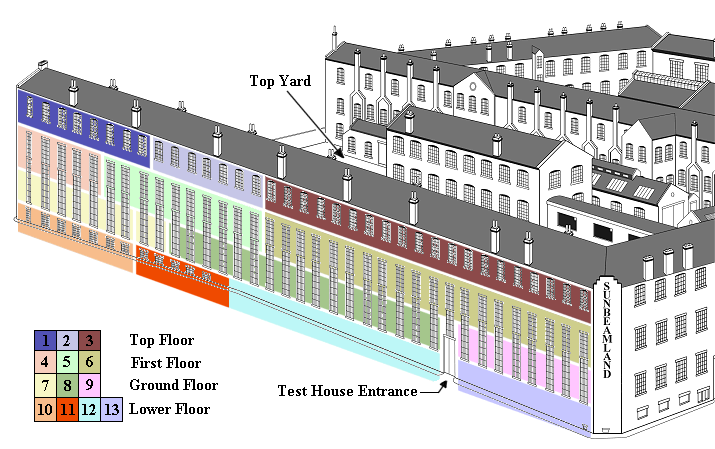
The buildings in Pool Street.
|
1. Cycle Finishing Shop where all
cycles were built except for 2-speed Golden Sunbeams.
2. Wheel Building Shop under Mr. Arrowsmith where
motorcycle and bicycle wheels were built.
3. Enamel and Polishing Shop run by Mr. Mason. For
general enamelling, lining of frames and petrol tanks, and a lot
of women and girls, pumice stoning, and polishing the finished
frames and forks (along the inside wall above top yard). There
were a number of enamelling vats, and hardening-off stoves
(along the outside wall below the chimneys).
4. Toolroom.
5. Engine and Gearbox Building Shop containing a row of
benches for the building of engines and gearboxes (engines on
Pool Street side, gearboxes on factory side). The foreman of the
engine bench was George Stephenson, who later moved to the
Development Department. He was succeeded by Mr. Robin,
inevitably known as ‘Cock’ Robin.
6. Motorcycle Finishing Shop under Jack Walton, where
the engine was put in the frame, and the motorcycle built and
completed. The inspectors were Harry Higgins, and Harry Idiens.
7. Polishing Shop.
8. General Machine Shop run by Arthur Cowen whose office
was at the Paul Street end of the machine shop. On the top yard
side, by the office was the sandblasting shop. In a small
extension on the inside wall, facing Top Yard, was the Tool and
Gauge Shop.
9. Test House. Tommy de la Hay, Alec Bennett, George
Dance, Albert Collins etc.
10. Canteen. The canteen lady, Nellie, cooked the chops
etc. that you brought-in for your lunch. She also worked in the
factory and started in the canteen at 12 o’clock.
11. Plating Shop (front), Blacksmiths Shop (rear).
12. General Stores for all raw materials, steel, brass
etc. and a small amount of sheet aluminium.
13. Tyre, Inner Tube, & Chain Case Shop, run by Mr.
Mason. |
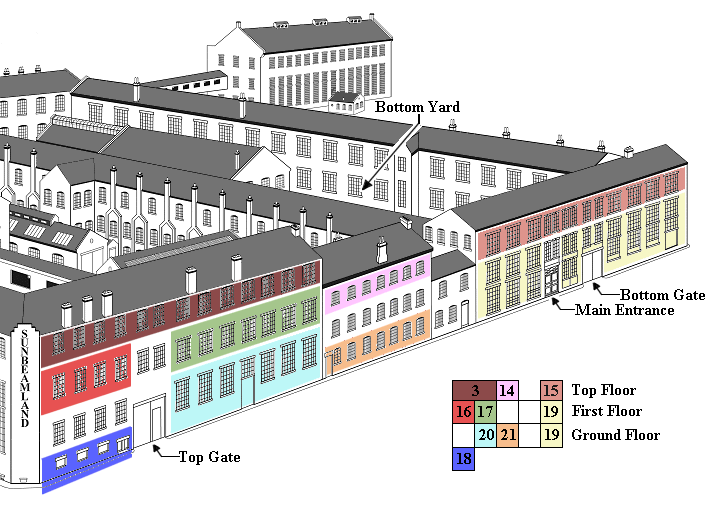
The buildings in Paul Street.
3. Enamel and Polishing Shop run by Mr. Mason. For
general enamelling, lining of frames and petrol tanks, and a lot
of women and girls, pumice stoning, and polishing the finished
frames and forks (along the inside wall above top yard). There
were a number of enamelling vats, and hardening-off stoves
(along the outside wall below the chimneys).
14. Drawing Office.
15. Main Office. At the Jeddo Street end was the
Managing Director’s (Sidney Bowers) office. Other offices
included the Secretaries Office run by Freddie Payne, the Buying
Office run by Billy Plant, the Buying Office, and the Finance
Office run by accountant Graham Bellingham.
Top Gate in Paul Street led into Top Yard. On the
left-hand side of the entrance was the stairs leading to the
Works Manager's Office, and the Wages Office. On the right-hand
side of the entrance was the time clock for clocking-in, and the
timekeeper’s office. Arthur Fisher was the timekeeper. He
previously worked in the Tube Shop cutting tubes to length.
16. Works Manager’s Office. F. T. Jones was works
manager. The Wages Office was at the back.
17. Development Department.
18. Boiler House. Heating for the factory.
19. Golden Sunbeam building shop for 2-speed bicycles.
The foreman was Mr. Weston.
Bottom Gate led into Bottom Yard and the Radiator
Despatch Department.
20. Motorcycle Packing House. Ernie Deacen Packing
Manager.
21. Golden Sunbeam stores. |
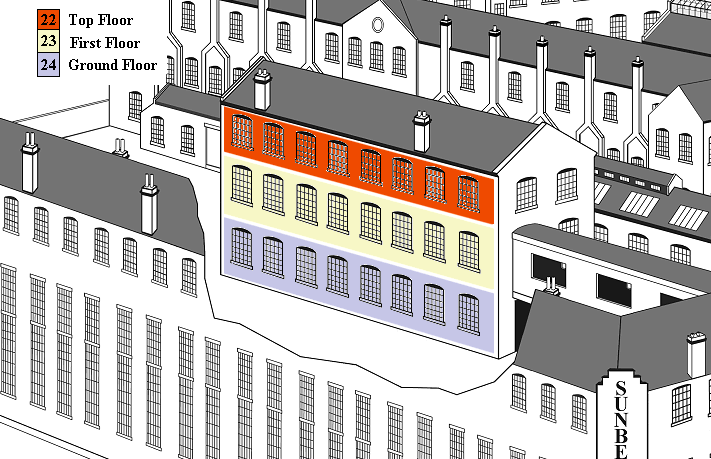
The old building in Top Yard.
|
22. Second Machine Shop run by Mr. Mountford. Known as Mountford’s Machine Shop.
23. Lug Shop. The malleable iron for the lugs came from
Greens in Lever Street.
24. Hatton Jig Department where the lugs were bent. |

The building on the opposite side of Jeddo Street.
|
25. Toolroom.
26. Tinsmiths Shop.
27. Bicycle Handlebar and Brake Lever Building Shop.
28. Brazing Shop. |
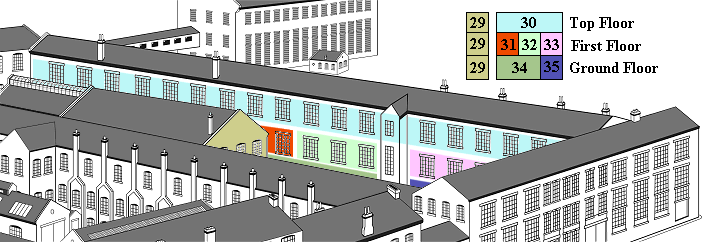
The building alongside Jeddo Street, and the building
in Bottom Yard.
|
29. Press Shop (hand presses).
30. Radiator Shop. Two large rolling machines which were
fed from rolls of copper, about 12 inches in diameter and
between 1½ inches to 5 inches wide. The machines produced
lengths of corrugated copper, which was cut to lengths of 3 to 6
feet, and crimped. The lengths were then taken to the girls who
operated small toggle hand presses, which pressed the ends and
lapped them together. There were soldering benches where the
radiator components were placed in a fixture, and dipped into a
solder bath.
31. Maintenance Department manned by electricians, tool
fitters, and building maintenance staff.
32. Pattern Store for tube patterns.
33. Frame Shop. Arthur Fox cut the tubes to length and
scalloped them to fit the lugs, all singly, no press work,
setting them with stick and plate gauges. They were pinned with
one eighth of an inch pegs, and sent to the Brazing Shop in Jeddo Street. Also the General Fabrication Department for petrol
tanks, chain cases etc. George Newman in charge, Bill Smith his
right-hand man.
34. Sheet Metal Stores.
35. Radiator Despatch Department.
A gas engine was near the back of Top Yard.
It drove the machines via overhead line shafting, and was
operated by Dick Corfield who used to cut people’s hair for
threepence a time.
All the lifts were rope-operated. The first
electrically powered lift was installed in about 1928 at the
back of the Pool Street building, in Top Yard.
Every department had an inspector who
regularly checked everyone’s work. Anyone producing sub-standard
work was often sacked on the spot. |
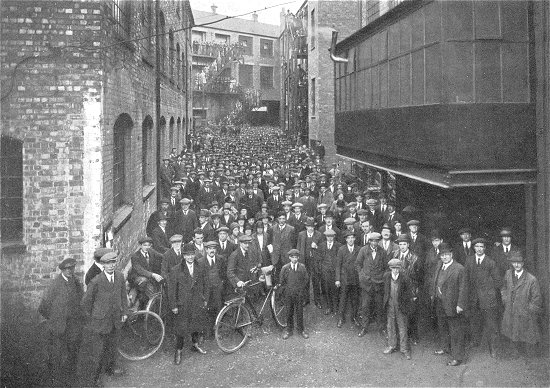
Sunbeam staff in Top Yard, looking towards Top Gate,
in 1928.

Looking towards Paul Street in the late 1960s.
| The photograph above shows the factory in its final form,
when it was owned by C. E. Marshall (Wolverhampton) Limited. The
building on the right acquired a flat roof in the 1934
alterations, when it was extended across the site of a small
2-storey building that was demolished. The 2-story building can
be seen in the drawings above.
During the Second World
War the company manufactured aircraft components, including
radiators, parts
for the De Havilland Mosquito, metal fuel tanks for Wellington
Bombers and other aircraft, pioneered the development of
flexible non-metallic fuel tanks, and self-sealing covers. In 1943, John Marston Limited,
part of ICI Metals Division, merged with another ICI subsidiary, the
Excelsior Motor Radiator Company Limited of Leeds, to form Marston
Excelsior.
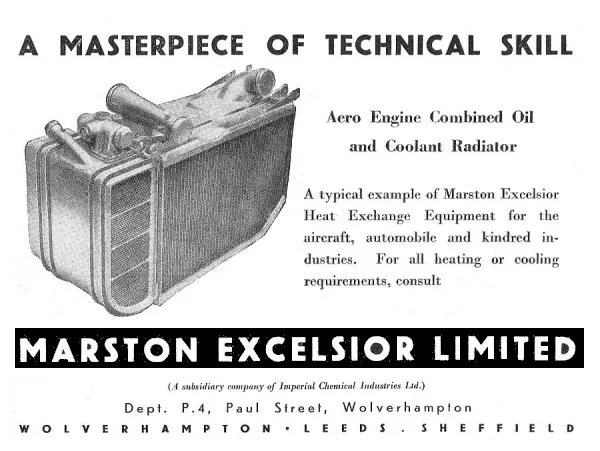
An advert from 1954.
The company became one of the country's leading producers of
cooling systems using a wide range of materials including
aluminium and cuprous alloys, uranium, zirconium, tantalum,
reinforced plastics and synthetic rubbers. The many products
included heat exchangers, pressure vessels, pipework, bursting
discs, special purpose machines, industrial fans, flexible tanks
for aircraft, bulk storage, and the transport of liquids. |
In 1967 the factory was taken over by C. E. Marshall
(Wolverhampton) Limited which specialised in diecasting,
electroplating, and general assembly work. The factory closed in
1999 with the loss of sixty jobs, and was acquired by
A. J. Mucklow & Company Limited. The firm leased it to Chubb until 2009
during which time it remained empty. In
August 2009 it was sold to Urban Splash for conversion into small
industrial units and offices. Sadly funds for redevelopment couldn't
be found, and so the property remained empty and in a vulnerable
state.
After many years of dereliction, the factory was finally acquired by
property developer Liam Wordley in 2013, and is now (in 2015) being
converted into around 115 apartments at a cost of about £10 million.
It finally looks as though its future has been secured. |
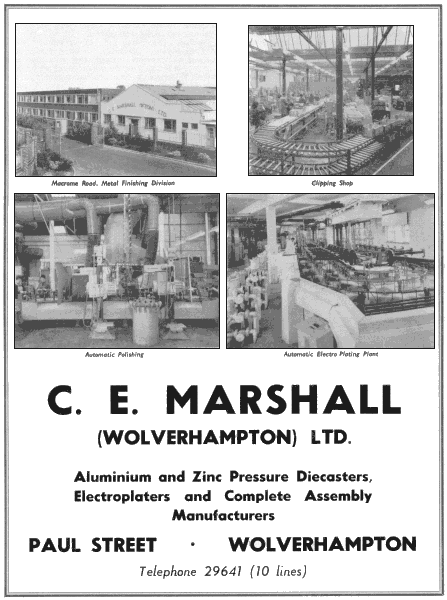 |
|
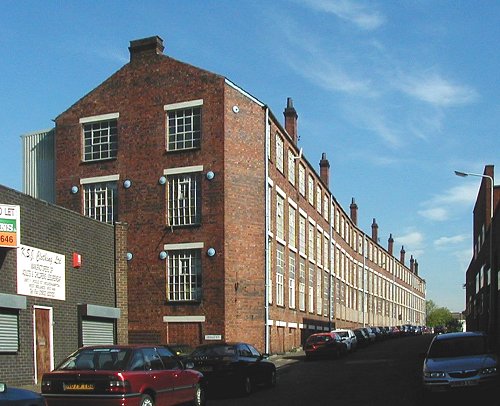
Looking up Pool Street in about 2000. |
This photograph shows the factory when it was still owned by
C. E. Marshall. At this time the buildings, although empty, were
in good condition, without a single broken window. Sadly,
after Marshalls sold the factory it rapidly declined. Most of
the windows were broken, and
boarded-up.
By 2009, most of the panels in the front door
were missing, affording easy access to the site. |
| Urban Splash secured the building with metal panels over the
windows and doors which prevented unauthorised access, and
vandalism. Although it became an eyesore, it saved the building
from damage and vandalism, and has allowed today's redevelopment to
go ahead. |
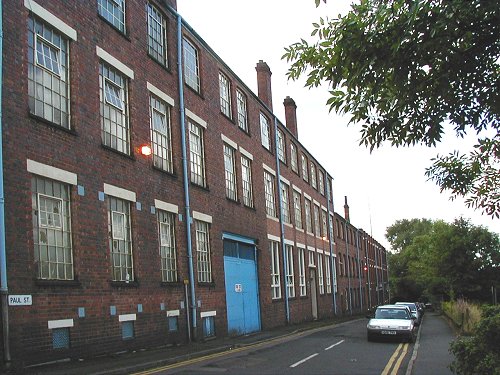
Looking along Paul Street in about 2000. |

|
|

|
|

|
| Return to Decline
and Fall |
|
Return to the
beginning |
|
Proceed to the
list of models |
|